MYTHS OF ANTAGONISM
Agonist and Antagonist? Really??
The common term for a muscle that is, suspiciously, called the “prime mover,” and its counterpart that does its opposite action - is “agonist” and “antagonist.”
“Agonist” comes from the Latin root for “combatant” and of course “antagonist” from the root for the “opponent” of the combatant.
So it would seem as though there is a kind of war or cage match at least between these two muscles.
This is wrong on so many levels. The good news is seeing why it’s wrong gives us insight into healthy kinesiological relationship (and in how to live!)
Ida Rolf famously said when flexors flex, extensors should extend. This truism tells us that every successful movement depends on the conjoined ability of two muscles to contract and to lengthen.
When, for instance, the biceps need to contract and lift a weight, to do so fully the triceps need to lengthen as much as the biceps shorten. When you bend your knee the hamstrings need to shorten and the quadriceps to lengthen.
So, first of all, there is no “prime mover.” There are just two muscles that cooperate in enabling movement. The triceps’ lengthening is as “prime” as the biceps’ shortening. I call them “circuit partners”, since they form a kind of circuit which allows for fuller, stronger, freer movement.
Embodiment:
Take you arm out in front of you to about 45°.
Now bring your awareness to your biceps muscle
And slowly contract it, bending your elbow.
Do this three times – and then see how that feels.
Now shake out your arm
Again put it out in front of you
And bring your awareness to your triceps.
Now slowly bend the elbow again feeling that, as you do so,
You are lengthening your triceps.
Do that three times – see how it feels.
When you bend your elbow with the awareness focused on lengthening the triceps, you can note and feel that letting go feels much smoother, lighter and much less effortful
We live in a culture, even in its anatomical views, that is focused on movement through effort, on movement by contracting.
How does it feel to know that our every movement happens equally by relaxing, by letting go?
Every graceful dancer, martial artist, athlete, has learned this, often intuitively through their practice – that moving with awareness of letting go, relaxation (balanced only by the contraction necessary) saves energy, adds grace, clarity and power to their every gesture.
Once we know and feel that, then we can appreciate these circuit partners involved in our every move that, in a perfect yin-yang, combine relaxation with activation.
May this awareness spread through our whole life, emphasizing letting go, since it’s been culturally neglected. Relaxing and letting go needs more attention in our lives than moving and living only by contracting.
Your deepest presence is in every small contracting and expanding,
the two as beautifully balanced and coordinated as birds' wings.”
- Rumi

